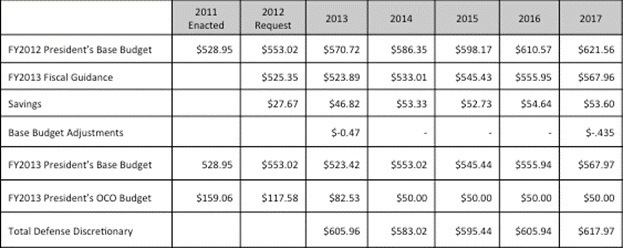OMB, DoD Agree On $523B 2013 Budget; Budget Chicken Begins
Posted on

WASHINGTON: President Obama’s defense budget for 2013 implements the start of the $500 billion in budget cuts required by the Budget Control Act but does not address the additional $600 billion in cuts triggered by the Super Committee’s failure.
The most important implication deduced from the chart above would be that the administration has begun playing budget chicken since it does not include any cuts that would be required by the sequestration triggered by Congress’ failure to cut $1.2 trillion last month.
Todd Harrison, a respected defense budget analyst at the Center for Strategic and Budgetary Assessments here, says in an email that, “this budget fits within the initial budget caps agreed to in the Budget Control Act” if the fiscal 2014 base budget number of $553 billion is a typo.
“It does not fit under the caps imposed by sequestration, which would reduce the base budget by about $54B below the amounts currently projected for each year,” he writes. “They could still develop a budget amendment for next year to show how they would revise the budget to fit under the sequestration budget caps. But otherwise, they are essentially playing a game of chicken with Congress over who will blink first in overturning sequestration.”
Mackenzie Eaglen, defense analyst and former Capitol Hill defense aide at the Heritage Foundation, says, “these numbers essentially split the baby on more defense cuts.” She predicts that Capitol Hill “will not react favorably to these figures, but they’re unlikely to move a defense spending bill for FY 2013 until after the election in FY 2014 anyway.”
Harrison notes that the administration does not seem to be playing a game many people expected they might try, namely moving money into the Overseas Contingency Operations (OCO) budget, which funds day-to-day warfighting. “In terms of OCO funding, the $82.5 billion requested is consistent with the number of troops they are projecting. Over the past six years the cost per troop in Afghanistan has averaged about $1.2M per troop per year, and that’s precisely what this budget works out to on a per troop basis,” Harrison says. “This suggests that they are not moving a substantial amount of money from the base budget to the OCO budget in order to get around the budget caps.”
The chart assumes “an average troop level of 68,000 for Afghanistan in 2013.”
As we move through the next six months, Eaglen says, “what Congress should be focusing on is the impact of pulling the ‘trigger’ halfway and the impact that will have on DoD program managers now, the civilian workforce furloughs and notification requirement times, and industry movement to quickly consolidate and downsize in the absence of clear guidance.
“The military isn’t going to be saved just because the trigger wasn’t pulled…” she says.
Subscribe to our newsletter
Promotions, new products and sales. Directly to your inbox.
